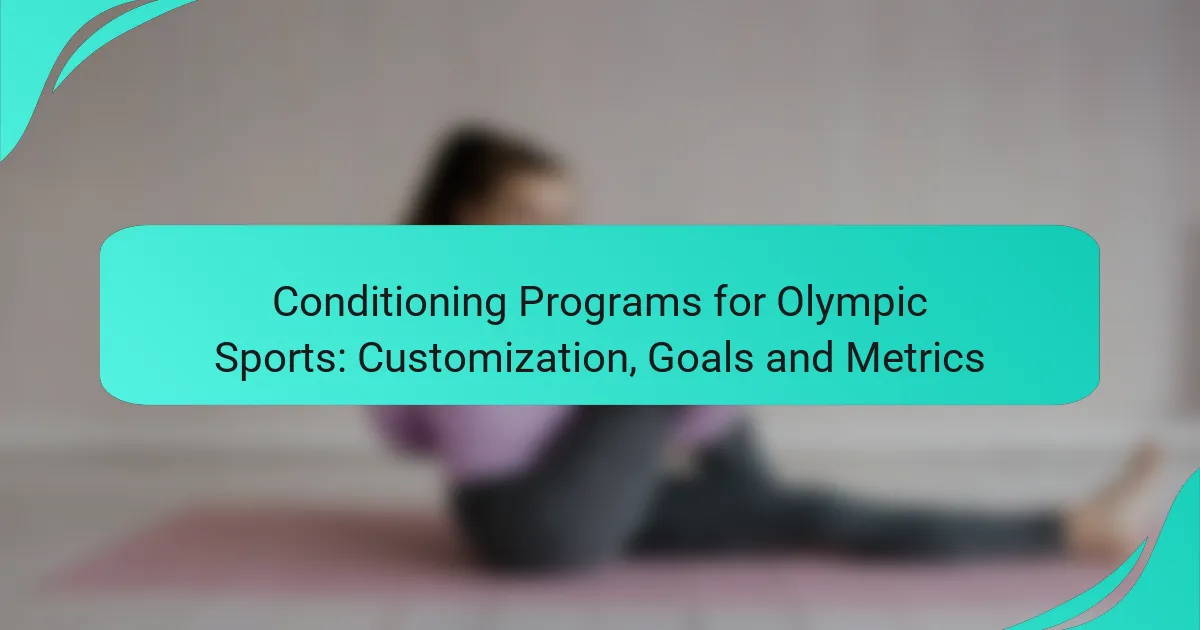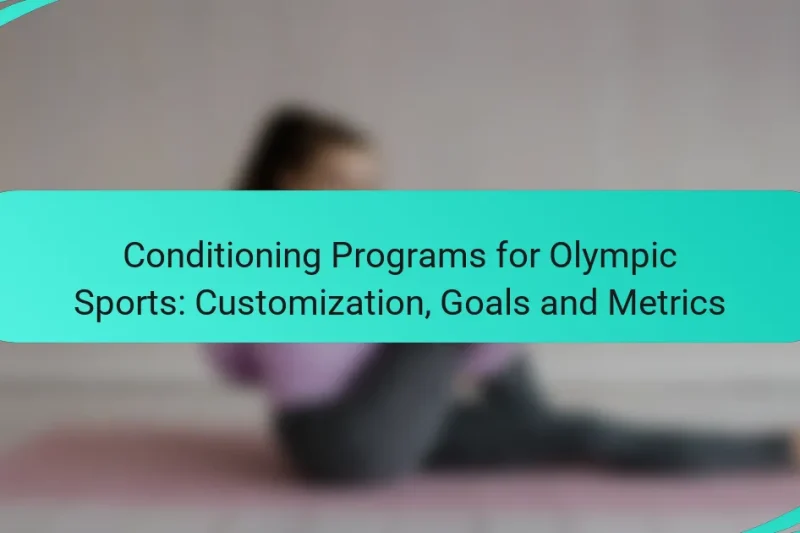Conditioning programs for Olympic sports are meticulously customized to meet the specific demands of each discipline, … Conditioning Programs for Olympic Sports: Customization, Goals and MetricsRead more
Olympic training methodologies are structured approaches designed to enhance athletic performance through systematic planning and execution. By focusing on key concepts such as periodization, sport-specific drills, and recovery, these methodologies help athletes optimize their training regimens and reach peak performance while minimizing injury risks.
Meal Planning for Olympic Athletes: Strategies, Tools and Benefits
Meal planning is essential for Olympic athletes, as it allows them to optimize their nutrition for … Meal Planning for Olympic Athletes: Strategies, Tools and BenefitsRead more
Cultural Dietary Practices: Impact on Olympic Performance and Adaptation
Cultural dietary practices play a crucial role in shaping Olympic athletes’ nutrition, directly impacting their performance … Cultural Dietary Practices: Impact on Olympic Performance and AdaptationRead more
Periodization Models: Effectiveness, Adaptation and Performance in Team Sports
Periodization models play a crucial role in enhancing performance in team sports by systematically varying training … Periodization Models: Effectiveness, Adaptation and Performance in Team SportsRead more
Cold Water Immersion: Benefits, Techniques and Best Practices for Recovery
Cold water immersion is a powerful recovery tool that can significantly reduce muscle soreness, enhance circulation, … Cold Water Immersion: Benefits, Techniques and Best Practices for RecoveryRead more
Technology for Monitoring Strength Progress: Tools, Metrics and Insights
Monitoring strength progress is essential for anyone looking to enhance their fitness journey, and a variety … Technology for Monitoring Strength Progress: Tools, Metrics and InsightsRead more
Block Periodization: Implementation Strategies and Weightlifting Techniques
Block periodization is a strategic approach to weightlifting that organizes training into distinct phases, each aimed … Block Periodization: Implementation Strategies and Weightlifting TechniquesRead more
Supplements for Olympic Runners: Types, Benefits and Timing
Supplements play a vital role in enhancing the performance of Olympic runners by supporting endurance, strength, … Supplements for Olympic Runners: Types, Benefits and TimingRead more
Visualization Techniques: Methods, Benefits and Applications
Visualization techniques play a crucial role in converting complex data into clear and accessible formats, enhancing … Visualization Techniques: Methods, Benefits and ApplicationsRead more
Periodization: Optimizing Performance and Strategies for Olympic Trials
Periodization is a strategic approach to training that optimizes athletic performance for Olympic trials by dividing … Periodization: Optimizing Performance and Strategies for Olympic TrialsRead more
What are the key Olympic training methodologies?
Key Olympic training methodologies include structured approaches that enhance athletic performance through systematic planning and execution. These methodologies focus on periodization, sport-specific drills, cross-training, recovery, and strength conditioning to optimize training outcomes.
Periodization training
Periodization training involves dividing the training year into distinct phases, each with specific goals and focuses. This method helps athletes avoid plateaus and overtraining by varying intensity, volume, and type of training throughout the year.
For example, an athlete may focus on building endurance in the early phase, strength in the middle phase, and peak performance before competitions. A typical cycle might last from several weeks to a few months, allowing for recovery and adaptation.
Sport-specific drills
Sport-specific drills are tailored exercises that mimic the movements and skills required in a particular sport. These drills enhance technique, agility, and overall performance by focusing on the unique demands of the sport.
For instance, a sprinter may practice explosive starts and acceleration drills, while a swimmer might focus on stroke mechanics and turns. Incorporating these drills into regular training helps athletes develop the necessary skills to excel in competition.
Cross-training techniques
Cross-training techniques involve incorporating different types of physical activities into an athlete's routine to improve overall fitness and reduce the risk of injury. This approach can enhance strength, flexibility, and endurance by engaging various muscle groups.
For example, a runner might include cycling or swimming sessions to build cardiovascular fitness while minimizing impact on joints. Athletes should aim for a balanced mix of activities, dedicating a few sessions each week to cross-training.
Recovery protocols
Recovery protocols are essential for athletes to restore energy, repair muscles, and prevent injuries. Effective recovery strategies include rest days, active recovery sessions, and techniques like stretching, foam rolling, and massage.
Implementing recovery protocols can vary from individual to individual, but athletes should prioritize at least one full rest day per week and consider light activities, such as yoga or walking, on recovery days to promote circulation and healing.
Strength and conditioning programs
Strength and conditioning programs focus on improving an athlete's physical capabilities through resistance training and conditioning exercises. These programs are designed to enhance strength, power, speed, and endurance, tailored to the specific needs of the sport.
A typical program may include exercises like squats, deadlifts, and plyometrics, with sessions lasting 45 to 90 minutes, 2 to 4 times per week. Athletes should work with a qualified coach to ensure proper technique and progression to maximize benefits while minimizing injury risk.
How do Olympic training methodologies enhance athlete performance?
Olympic training methodologies significantly enhance athlete performance by integrating advanced techniques that focus on physical conditioning, skill development, injury prevention, and mental resilience. These methodologies are designed to optimize training regimens, ensuring athletes reach their peak potential while minimizing risks.
Improved physical conditioning
Olympic training emphasizes comprehensive physical conditioning, which includes strength, endurance, flexibility, and speed. Athletes often engage in periodized training programs that vary intensity and volume to avoid plateaus and enhance overall fitness. For example, a sprinter might alternate between sprinting drills and strength training to build explosive power.
Incorporating cross-training can also be beneficial, allowing athletes to develop different muscle groups while reducing the risk of overuse injuries. This approach not only improves performance but also contributes to long-term athletic longevity.
Enhanced skill acquisition
Skill acquisition in Olympic training focuses on deliberate practice and technique refinement. Athletes engage in repetitive drills that target specific skills, allowing for muscle memory development and improved execution under pressure. For instance, a gymnast may practice routines multiple times to perfect their form and timing.
Utilizing video analysis and feedback from coaches can further enhance skill acquisition, providing athletes with insights into their performance and areas for improvement. This method ensures that athletes can adapt and refine their techniques effectively.
Injury prevention strategies
Injury prevention is a critical component of Olympic training methodologies, emphasizing the importance of proper technique, recovery, and conditioning. Athletes are trained to recognize their physical limits and incorporate rest days to allow for recovery. For example, a weightlifter might follow a structured program that includes lighter training days to prevent strain.
Additionally, implementing warm-up and cool-down routines, along with flexibility exercises, can significantly reduce injury risks. Athletes should prioritize listening to their bodies and seeking medical advice when experiencing pain or discomfort.
Psychological resilience
Psychological resilience is cultivated through mental training techniques that help athletes cope with the pressures of competition. Olympic training often includes visualization, goal-setting, and mindfulness practices to enhance focus and reduce anxiety. For instance, an athlete might visualize their performance before a competition to boost confidence.
Building a strong support system, including coaches and sports psychologists, can also aid in developing mental toughness. Athletes should engage in regular mental conditioning sessions to prepare for the psychological demands of high-stakes events.
What are the benefits of periodization in Olympic training?
Periodization in Olympic training offers several benefits, including improved performance, reduced injury risk, and enhanced recovery. By systematically varying training intensity and volume, athletes can optimize their physical capabilities and peak at the right time for competitions.
Optimized training cycles
Optimized training cycles allow athletes to focus on different physical qualities at various times throughout their training year. This approach typically includes phases such as endurance, strength, and power, each lasting several weeks to months. For example, a weightlifter might spend 8 weeks building strength before transitioning to a 4-week power phase.
By structuring training in cycles, athletes can ensure that they are not only improving but also avoiding plateaus. This method promotes continuous adaptation and helps maintain motivation through variety.
Peak performance timing
Peak performance timing is crucial for Olympic athletes, as they need to be at their best during competitions. Periodization helps athletes schedule their training to coincide with major events, ensuring they reach peak condition when it matters most. For instance, an athlete might taper their training volume in the weeks leading up to the Olympics to maximize energy and readiness.
Effective peak timing requires careful planning and monitoring of training loads. Athletes should track their performance metrics and adjust their training as needed to ensure they are on track for peak performance.
Reduced overtraining risk
Reduced overtraining risk is a significant advantage of periodization. By varying training intensity and volume, athletes can prevent the physical and mental fatigue that often leads to overtraining syndrome. For example, incorporating lighter training weeks can help athletes recover while still maintaining fitness levels.
To further mitigate overtraining, athletes should listen to their bodies and adjust their training plans based on how they feel. Regular assessments and recovery strategies, such as active rest days or cross-training, can also play a vital role in maintaining overall health and performance.
How do athletes implement sport-specific drills?
Athletes implement sport-specific drills by focusing on exercises tailored to their particular sport, enhancing skills crucial for performance. These drills are designed to mimic game situations, allowing athletes to practice techniques and strategies in a controlled environment.
Technique refinement
Technique refinement involves breaking down complex movements into manageable parts, allowing athletes to focus on precision and form. For example, a sprinter may work on their starting block technique separately from their running stride. This targeted approach helps in identifying weaknesses and improving overall efficiency.
Coaches often use video analysis to provide immediate feedback, enabling athletes to make real-time adjustments. Regularly scheduled technique sessions can lead to significant improvements over time.
Game scenario simulations
Game scenario simulations recreate actual competition conditions, helping athletes adapt to the pressures and dynamics of their sport. These drills often include situational plays or tactical scenarios, allowing athletes to practice decision-making and teamwork under stress.
For instance, a basketball team might run plays against a defense to prepare for specific matchups. Incorporating game-like elements into training can enhance readiness and confidence during actual competitions.
Skill repetition for mastery
Skill repetition for mastery emphasizes consistent practice of fundamental skills until they become second nature. Athletes typically engage in repetitive drills that focus on key skills, such as shooting for basketball players or passing for soccer players.
To maximize effectiveness, athletes should vary their practice conditions, such as changing the intensity or environment. This approach helps in solidifying skills and preparing athletes for the unpredictability of real-game situations.
What role does cross-training play in Olympic training?
Cross-training is essential in Olympic training as it enhances athletic performance while minimizing the risk of injury. By incorporating various physical activities, athletes can improve their overall skills and fitness levels, which is crucial for competing at high levels.
Injury risk reduction
Cross-training helps reduce the risk of injuries by allowing athletes to work different muscle groups and avoid overuse. For instance, a runner might incorporate swimming or cycling to maintain cardiovascular fitness without the repetitive impact of running.
Additionally, varying training modalities can strengthen stabilizing muscles and improve flexibility, further protecting against injuries. Athletes should aim to include cross-training sessions at least once or twice a week to balance their training regimen.
Enhanced overall fitness
Incorporating cross-training into Olympic training enhances overall fitness by developing strength, endurance, and flexibility simultaneously. For example, a weightlifter might include yoga sessions to improve flexibility and core strength, which can translate to better lifting performance.
Moreover, cross-training can prevent mental burnout by introducing variety into training routines. Athletes should consider mixing in different sports or activities that complement their primary discipline to maintain motivation and improve their physical capabilities.














